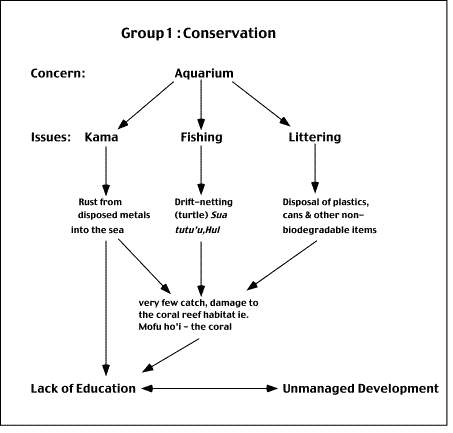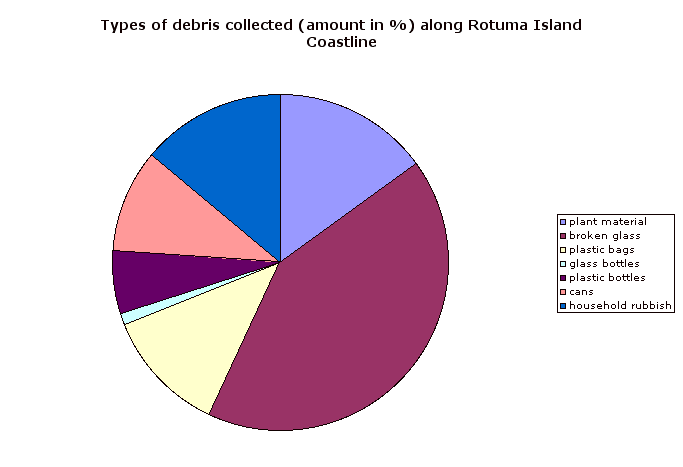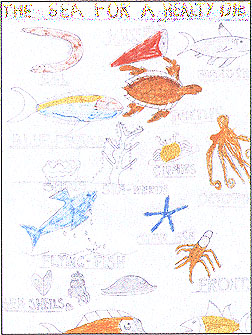|
Phase 1 - Annual
Report 2002
LäjeRotuma Initiative was started
up in 2002 by a number of Rotuman university graduates.
LäjeRotuma is an environmental awareness
development program for Rotuma Island.
Contents
LäjeRotuma vision and goal
Noa'ia'e
mauri!
Environmental Concerns
Training of Trainers
Training of Island Youth
Primary Poster Competition
Rotuma Coastline Clean-up
Community Outreach
Transects & Manta Tows
LäjeRotuma assists
Finance
LäjeRotuma Partnerships
LäjeRotuma Contacts
Vision
To maximize the future, environmental and sustainable options for
the island of Rotuma and her people.
Goal To strengthen natural
resource management, with particular emphasis on marine life and of
the Rotuman community living on the island for the benefit of the
current and future generations.
Noa'ia'e
mauri!
The year 2002 for LäjeRotuma, has been a challenging one. I grew
up on the home island and over the years noticed the changes; this
echoed by many and changes which didn't seem to improve over time.
In response, to such environmental concerns, LäjeRotuma was initiated.
The birth of a vision from a simple idea, has created the spirit of
community conservation on the island and sparking interest from related
fields of research. For many of us involved in the Initiative, it
has been an enriching experience and the dawn of the new year brings
new responsibilities for LäjeRotuma. A special mention of the
families and friends of LäjeRotuma who
have assisted or contributed in kind to the Initiative. Noaia 'e hanisi
to those who have gone out of their way to open their doors and mind
to learn and listen and to the donor community who funded the Rotuma
trips. It is with hope and prayer that the Initiative becomes that
of a people's vision for their home island.
Hanisiof
Monifa Fiu [Coordinator]
Environmental
Concerns
The coral reefs and marine ecosystems of the Pacific islands are among
the most important natural assets on Earth. Many Pacific Islanders
live close to the sea in dispersed village communities that depend
on marine life for their protein supply. Their lives, customs, languages
and knowledge are linked inextricably with the ocean and island shores.
Rotuma Island with an approximate land area of 43 sq. km, located
about465km North of the Fiji Islands, like other Pacific islands are
experiencing the brunt of over exploitation of its marine ecosystem.
Environmental Concerns raised by the
islanders:
- Smaller sized and reduced catch to
date (inshore fisheries)
- Reduction in fishing holes within
the lagoon, clogged by an unknown fast-growing coral species, a
local phenomenon called kama
- Irresponsible dumping of household
rubbish to the foreshore
- Coastal erosion and Coral Bleaching
LäjeRotuma envisions the interaction
between traditional knowledge and scientific study, to enhance the
islanders' understanding of their island environment.
Training
of Trainers
WWF supports Rotuman youth initiative to promote conservation on the
island....
A workshop facilitated by the World Wide
Fund for Nature (WWF) Fiji Country Program, was aimed at equipping
the young trainers in participatory skills and tools designed to allow
them to conduct community-based training workshops on environmental
awareness at the home island.
- Visualizing resources & gathering
Information-traditional knowledge & history
- Understanding the community
- Concerns & Opportunities- Identifying
Problems and devising solutions
- Dreams & Visions
Training
of Island Youth Trainers
Community Resource Conservation Workshop-
Participatory Learning & Action Tools



Rotuma
Primary Posters Competition 2002
The 4 primary schools
on the island had a poster competition on a variety of themes focusing
on Rotuma. The posters reflect the abundant marine life, a youngster's
knowledge of his or her home island.
Winning Poster - Paptea District School

 |
|
Christ the King Primary School |
Malhaha Primary School |

Motusa Primary School
Coastline
Clean-up
The coastline clean-up is part of the
Coral Reef Alliance Dive in to Earth Day Network. The Rotuma
coastal clean-up was carried out a week before the Rotuma Day celebrations
on May 13th 2002 and coordinated by the Island Coordinator, Youth
Trainers, and the Rotuma Health Inspector. A total of 422 volunteers
took part in the event.
| District |
Amount of debris collected
(Percentage) |
Average amount of debris
collected per volunteer |
| Noa'tau |
23% |
1.5 |
| Oinafa |
4% |
5.0 |
| Pepjei |
25% |
2.7 |
| Malhaha |
12% |
1.1 |
| Juju |
9% |
2.9 |
| Itu'ti'u |
16% |
6.1 |
| Itu'muta |
11% |
1.1 |
The table shows the amount of debris
collected (in percentage) per district on its clean-up day. It also
reflects the level of participation.

Community Outreach
Evening Sessions --The People's Forum
Some of the Questions and Issues raised with LäjeRotuma
by the islanders:
- Who is LäjeRotuma? What are its plans for
the island?
- What is happening in the sea- i.e. the kama
phenomenon? the smaller sized catch (inshore fisheries) as compared
to before?
- Coastline pollution-dumping of household rubbish
to the beach!
- The use of pesticides and weedicides by the villagers
on their land. How harmful is it to the land?
- Villagers' observations of the changes- seasons
and how rare it is to catch octopus!
- Coastal erosion and the observed changes along
the coastline by the villagers due to coastal processes.
- The reduced number of canoes and some of the traditional
fishing methodc like the use of fish traps, women's (mostly) use
of nets for "sua tutu'u".
- The debate over the harmful use of some of the
traditional fishing methods- use of plant poison "tuah
niukin ta".
- Coral Biology-basic understanding of coral reef
ecology as explained by the science team! The bleaching of corals!
The villagers tell of past business schemes or events that is believed
to have an impact on the observed absences of certain species of
fish and changes in ‘their’ lagoons e.g., the beche-der-mer,
lobster export business.
- Why a coastline cleanup? Who is responsible for
debris brought along by the tide from elsewhere?
- The role of the health inspector and uphold of
both communal and public health and safety regulations! To revive
the old communal laws regarding the cleanliness of the community-imposed
and assisted by the chiefs in their districts.
Transects
Collected specific information about the environment, resources
and human use of the area.
Rotuma has a central chain of forest-clad
peaks and undulating coastal flats of varying width. Its volcanic
soil is very rich, supporting luxuriant growth of plants. The 4 land
transects from 4 distinct mounts on the island provide a cross-section
of the island's vegetation and how the land is used, In overall, the
4 transects reflect that much of the land is used farming, creating
pig pens, and clearing for dwellings, closer to the coastline. Further
survey is needed to identify the plant types found, in particular,
at the top of the mount where older, mature trees seem to have survived
without much disturbance.
A narrow sandy isthmus (Motusa) connects
the two essentially distinct parts of the island. Well-developed fringing
reefs surround the island and the reef flat is narrow in all but a
few places (notable the Southeast corner). Two anchorages on the North
shore provide adequate shelter from South East trade winds. A wharf
has recently been repaired and extended at Oinafa. Rotuma is divided
into 7 districts (refer to drawn map): Noatau, Oinafa, Pepjei, Juju,
ltu'muta, ltu'ti'u, Malhaha, headed by a traditional chief. These
chiefs with an elected district representative make up the Rotuma
Council, the ultimate authority on the island. Inter-island vessels,
both government and charters have long been the only means of transport
of goods and people to and from the island. The presence of an airstrip
has made it possible for at least two-weekly flights from Suva, Fiji.
Cooperatives and small privately owned shops play a dominant role
in the commerce of the island; importing consumer goods and handling
agricultural produce. The radio telephone facilities at Ahau Government
Station, and the installation of telephones in individual homes, has
improved communication with Fiji.
Marine resources represent a big source
of subsistence protein, which is heavily supplemented by imported
tinned stuff, Many use punts and outboard motors for in particular,
deep sea fishing. Efficient fishing methods with the use of nylon
lines, steel hooks and lures, enable the fishers to venture outside
the lagoon. Outrigger canoes are few in numbers. Inshore fishing primarily
involves: small gill nets used intermittently; spearing fish and lobsters;
collecting shellfish on the reef flat; hand-lining from canoes and
on along the shore.
Figure a: The map shows LäjeRotuma's
Actions in 2002 - Phase 1

Note: This map is not drawn to scale.
Table 1. Sites used for manta tows. Refer to map for
locations of each tow..
| Site Code |
Site name/General location |
GPS Start |
| NIT NO 1 |
Sunflower Reef Noatau - outer slope |
S 12 31.771, E 177 07.282 |
| MT AO 1 |
Ed's Diner, Ahau--Malhaha - outer slope |
S 12 29.538, E 177 02.770 |
| MT MA 1 |
RHS-Elsee, Malhaha - outer slope |
S 12 28.595, E 177 04.476 |
| NIT 10 1 |
Jelly fish, Ahau-Fataito'a Pt. - outer slope |
S 12 29.775, E 177 02.557 |
| MT MO 1 |
Rambo Reef, Motusa - outer slope |
|
Table 2. Hard coral, dead coral and soft coral score
for manta tows in Rotuma.
| Site Code |
Live Coral |
Dead Coral |
Soft Coral |
Visibility(m) |
General Features |
| MT AO 1 |
2 |
1 |
0 |
12 |
Reef slope |
| MT I0 1 |
1 |
2 |
0 |
6 |
Reef slope, grooves |
MT MO 1 |
2 |
2 |
0 |
18 |
Reef slope |
| MT NO 1 |
2 |
2 |
0 |
18 |
Reef slope, channels |
| MT MA 1 |
2 |
3 |
0 |
12 |
Steep reef slope |
The manta tow data reflects area surveyed as
having relatively fair, percentage live coral cover. There was no
soft coral cover noted during the manta tows at areas highlighted.
Seagrass meadows found at Motusa Bay.
LäjeRotuma assists
- Coral Reef Survey Training -David Solomone (volunteer),
LäjeRotuma sponsored his diving insurance, $200FJD.
- First Aid Training - 2 PLA Community trainers acquired
their Basic First Aid Certificates with Fiji Red Cross.
Finance
LäjeRotuma Income & Expenditure Statement for 2002
| Income |
FJD$ |
|
World Wide Fund for Nature-SPP, Fiji
|
$1,000 |
|
PADI AWARE Foundation
|
$1,000 |
|
PADI Foundation
|
$4,197 |
|
Suva 7-Districts Committee
|
$500 |
|
Alan Howard & Jan Rensel
|
$350 |
|
IOI - Pacific Islands
|
$1,000 |
|
Interest Earned
|
$0.35 |
|
| Total Income |
|
$8,047.35 |
| Expenditures |
|
|
Training of Island Youth
|
$1,004.36 |
|
Air Fiji Travel
|
$776.20 |
|
Primary Poster Program
|
$767.67 |
|
Fuel & Lantern
|
$427.20 |
|
Rotuma Day Poster Display
|
$244.00 |
|
Island Coastline Cleanup
|
$354.26 |
|
High School Program
|
$862.97 |
|
Training of Volunteers-Open Day
|
$387.05 |
|
Dive Training-Coral Reef Survey
|
$200.00 |
|
Final Consultation Trip (Community Outreach)
|
$1,860.48 |
|
Miscellaneous
|
$644.50 |
|
| Total Expenditure |
|
$7,528.69 |
| Remaining Balance |
$518.66 |
|
| Less Bank Charges |
$87.00 |
|
| Plus interest earned |
$0.12 |
|
| Funds Remaining for 2003 PHASE 11 |
|
$431.78 |
Partnerships
The Coral Reef Alliance (CORAL)
Global Coral Reef Monitoring Network (GCRMN)
International Coral Reef Initiative
International Ocean Institute- Pacific Islands (IOI)
PADI Project AWARE Foundation
PADI Foundation
World Wide Fund for Nature, South Pacific
Rotuma Website- Alan Howard
Fiji Government- Mrs Marieta Rigamoto
Rotuma Island Council
Rotuma Health Inspector- Mr Henry Vafo'ou
District Officer-Rotuma, Mr Luke Moroivalu
Suva Rotuman 7-Districts Committee
Churchward Chapel Community
Nadi-Rotuman Community
Air Fiji
University of the South Pacific
MV Bulou ni Ceva
MV Cagi Mai Ba
Technical Assistance
Department of Environment, Fiji - Library Services
Lisette Wilson [WWF]
Johnson Seeto [MSP, USP]
Fiu Manueli [MSP, USP]
Mausio Ralifo, Lavenia Jiosefa [USP]
Susau Ralifo, Luisa Finiasi, Murray Isimeli
Läje Rotuma Contacts
| |
Contact |
| 1. Monifa Fiu (Coordinator) |
PO Box 10816, Laucala Beach Estate
S95008395(@student.usp.ac.fj,
lajeroturna@hotmail.com |
| 2. Marseu Manueli (Island Coordinator) |
c/- Motusa Primary School, Rotuma. |
| 3. Louise Isimeli (Assistant Coordinator) |
Tel:(679)3479304[H], lisimeli@qovnet.qov.fj |
| 4. Mahlon Isimeli |
Isimeli@datec.com.fj |
| 5. Timaima Ratuki (Finance) |
Timaima.atuki@tfl.com.fj |
| 6. Nofaga Sakimi (Physics-Fuel Energy) |
PO Box 5037, Raiwaqa, Suva.
Tel: (679)3387607 [H]
S95008230@student.usp,ac.fj |
| 7. Rupeni Mario (Energy-SOPAC) |
Tel: (679) 3381377 Ext.245
rupeni@sopac.org
rupsem@yahoo.com |
| 8. Sidney Malo (Marine Studies) |
Tel: (679) 9955425 [M],
3321231 [H], malo_s@usp.ac.fj |
| 9. Maniue Vilsoni |
c/- Marist Brothers High School |
| 10. Freddy Tavokai |
redcross@is.com.fj |
| 11. Elizabeth Erasito |
Tel: (679)3313519, nationaltrust@is.com.fj |
| 12. Lisette Wilson |
Tel: (679)3315533,
lwilson@wwfpacific.org.fj |
| 13. Alfred Ralifo |
PO Box 262, Nadroga Provinc. High School |
| 14. Eric Rafai |
Medical Centre, Taveuni |
| 15. Tukaha Mua |
tmua@fijitv.com.fj |
| 16. Pene Samisoni |
Tel: (679)3387689 |
PLA Trainers List:
1. Abel Camillo
2. Fesikato'a Isimeli
3. Ruth Isimeli
4. Kauata Fatiaki
5. Emi Tanu
6. Rosarine Rigamoto
7. Elenoa Rigamoto
8. leli Raki
9. Robert Rigamoto
Rotuma Youth Trainers Principal
1. Faga
2. Fauoro
3. James
4. Mareta
5.Fanny
6. Varna
7. Hazel
8. Ilisapeti
9. Ritia
Volunteers List:
Luisa Antonio
Manueli Fiu
David Solomone
Anare Caucau
Madonna
Rotuma Island Network:
District Officer
Health Inspector
Headmistresses
Principal
Chairman
Medical Officer
|









